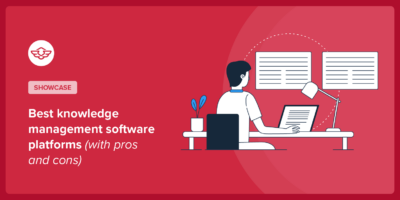11 Best Policy and Procedure Manual Software (Free and Paid)
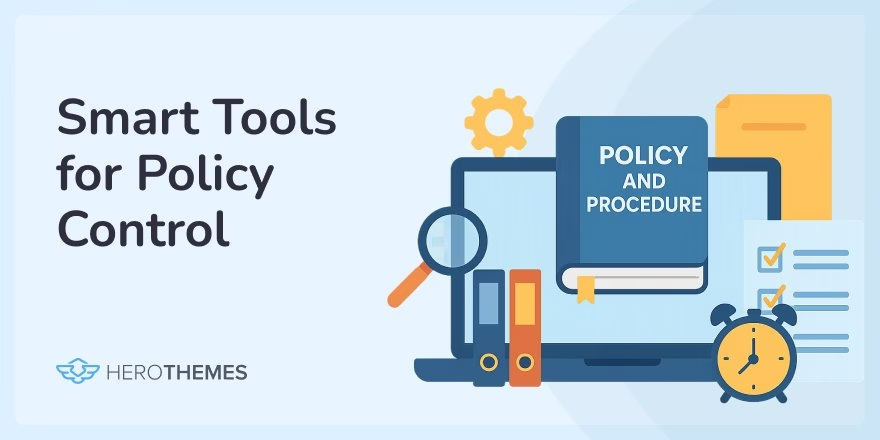
Managing company policies and procedures shouldn’t feel like herding cats. Finding relevant docs, outdated info, users that just don’t go through policies at all are just some examples of what you might be facing.
This causes problems for the company and its users.
That’s where policy and procedure manual software comes in:
- A centralized portal to manage all your policy and procedure manuals
- Checklists, quiz, and a signature system to make sure users read and accepted your terms
- Feedback, analytics to find outdated content
And many more features that make it worth looking at policy and procedure manual software.
In This Guide
- How I Researched for the Best Policy, Procedure Manual Software
- Best Policy and Procedure Manual Software in 2025
- 1. Heroic Knowledge Base: Best Choice
- 2. NAVEX PolicyTech: Compliance-Focused Policy Management
- 3. PowerDMS: Policy Manual Software for Public Safety and More
- 4. ComplianceBridge: Lightweight Policy Management for SMBs
- 5. Process Street: SOP and Workflow Tool for Procedures
- 6. Trainual: Playbook Builder for Small Businesses
- 7. SweetProcess: Simple Tool to Document Processes and Policies
- 8. ConvergePoint: Policy Management on SharePoint
- 9. RLDatix: Healthcare-Focused Policy Management
- 10. Atlassian Confluence: Team Wiki for Policies and Procedures
- 11. Notion: All-in-One Workspace for Manuals and More
- 1. Heroic Knowledge Base: Best Choice
How I Researched for the Best Policy, Procedure Manual Software

We rigorously test and research every product that we recommend through HeroThemes. Our review process. We may also earn a commission if you make a purchase through our links.
Here are few things I done to create this guide on best policy and procedure software:
- I’ve tried everything, from enterprise-grade platforms to scrappy, free tools.
- We don’t rely on affiliate marketing or sponsorship. Thus, I can freely express my opinions.
- I conflicted my opinions with online reviews and user problems.
- Every software here was evaluated for ease of use, key features (like version control, approvals, and search) and pricing value.
My goal is simple: find solutions that actually make managing policies and procedures easier, whether you’re a small business or a global enterprise.
Best Policy and Procedure Manual Software in 2025
1. Heroic Knowledge Base: Best Choice
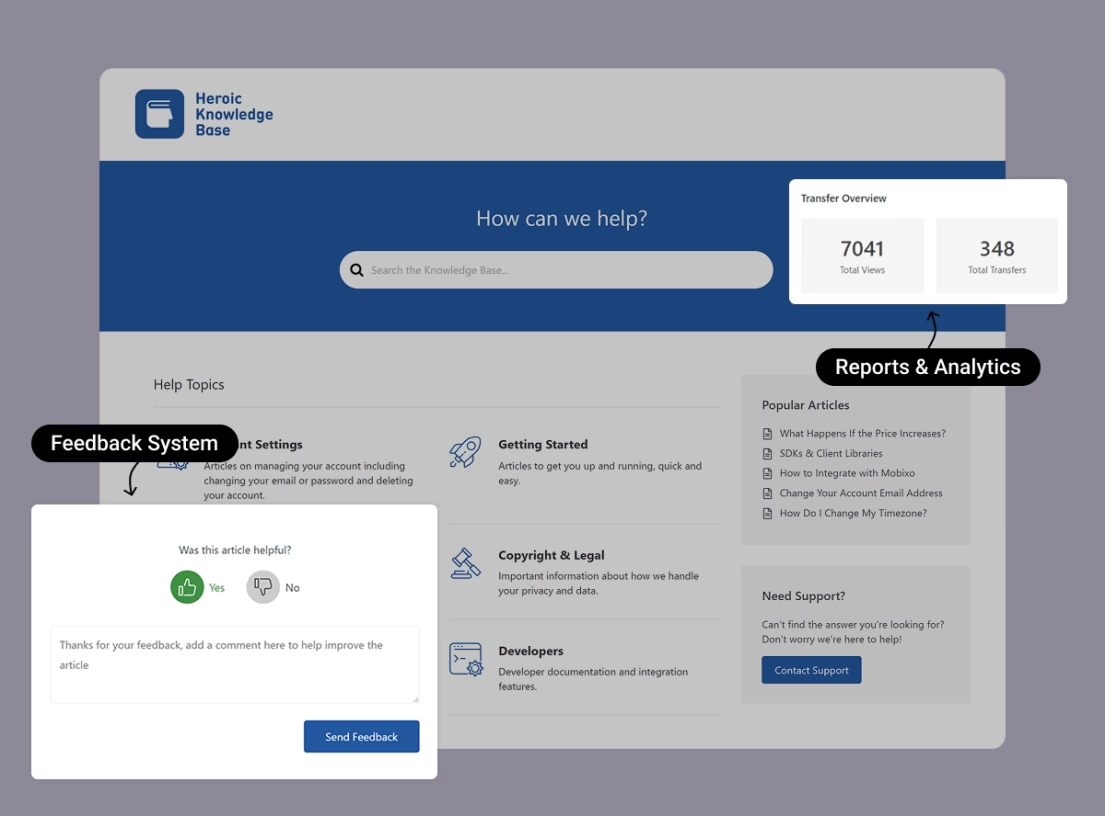
Heroic Knowledge Base is a popular solution to turn your website into a sleek, searchable policy manual or help center.
It’s trusted by over 31,000 businesses worldwide and boasts a stellar 4.5/5 rating from users.
Essentially, Heroic Knowledge Base lets you create an internal wiki or public-facing knowledge base without coding.
Many companies use it to publish HR policies, SOPs, or product documentation all in one place.
Key Features
- Intuitive Organization: Create categories, subcategories, and tags to structure your content. It supports multi-level hierarchies, so you can neatly nest “HR Policies > Leave Policy”.
- Rich document builder (No code solution)
- Instant Search: Lightning-fast AJAX search that suggests answers as you type.
- Access Controls: You can restrict certain categories or articles to logged-in users only, perfect for an internal policy manual.
- Feedback System: Users can rate articles, and leave feedback on articles.
- Analytics: The built-in analytics show search terms, popular pages, and even which searches got no results. Goldmine data for improving your documentation.
- AI Assistant: Integrate a ChatGPT based AI assistant with your knowledge base to get answers faster based on your data.
- The WordPress block editor and available features offer intense customizability.
Pricing
Heroic Knowledge Base is a premium solution (no free version, unfortunately). Plans start at $67 per year for a single site.
Compared to other SaaS knowledge base software with similar features, Heroic KB is a cost-effective choice that doesn’t compromise on features or quality.
My Take
Heroic Knowledge Base is a best choice for creating internal portals to host policies and procedures. It packs all the necessary features to manage your company documents in a safe and secure environment.
2. NAVEX PolicyTech: Compliance-Focused Policy Management
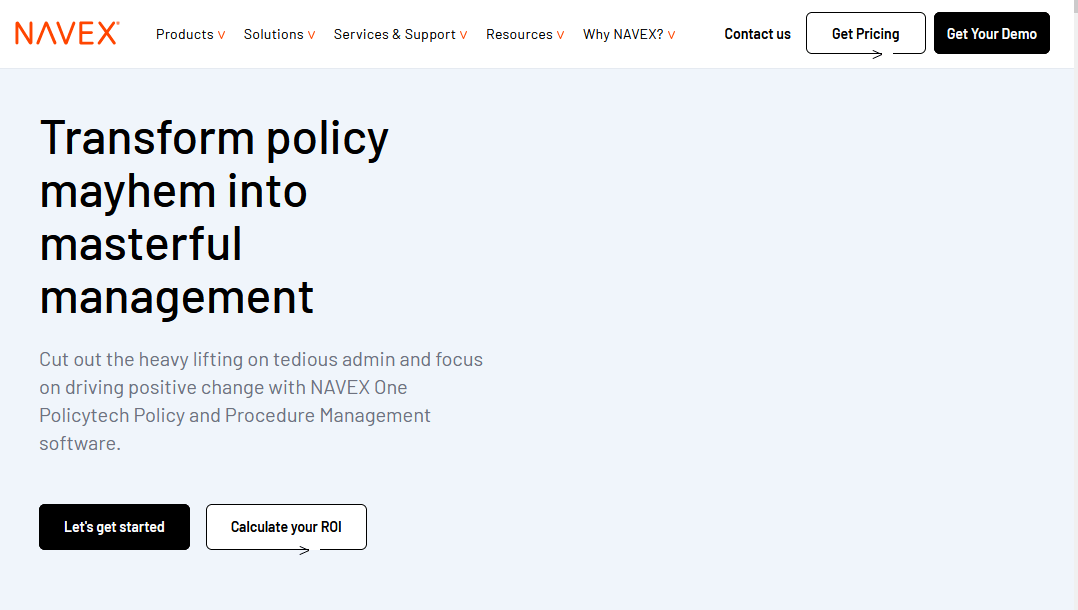
NAVEX PolicyTech (part of the NAVEX One platform) is a heavyweight solution designed for strict compliance and regulatory environments.
If you work in a field like finance, healthcare, or any industry where audits and acknowledgments are serious business, PolicyTech was built for you.
It’s not just a repository of documents; it actively helps you create, distribute, and track policies throughout their lifecycle.
NAVEX is a well-known name in governance, risk, and compliance (GRC), and PolicyTech is one of their flagship products for policy management.
Key Features
- Central Policy Library: At its core, it provides a secure, centralized library where all your policies and procedures live.
- Workflow Automation: PolicyTech shines in automating the draft → review → approve → publish workflow.
- Acknowledgment Tracking: You can require employees to attest (i.e., confirm they’ve read) a policy. PolicyTech will send out notifications to employees, quiz them if needed, and log their acknowledgements with timestamps.
- Compliance Monitoring: It can map policies to regulatory requirements, flag gaps, and ensure you are audit-ready with full audit trails.
- User-Friendly Interface
Pricing
NAVEX doesn’t list prices publicly (common with enterprise software). Pricing is typically quote-based and can depend on the number of users and modules needed.
My Take
If you are serious about compliance, NAVEX PolicyTech is worth a look. It’s engineered for policy oversight in a way simpler wiki tools aren’t, ensuring no one slips through the cracks when a new policy goes live.
3. PowerDMS: Policy Manual Software for Public Safety and More
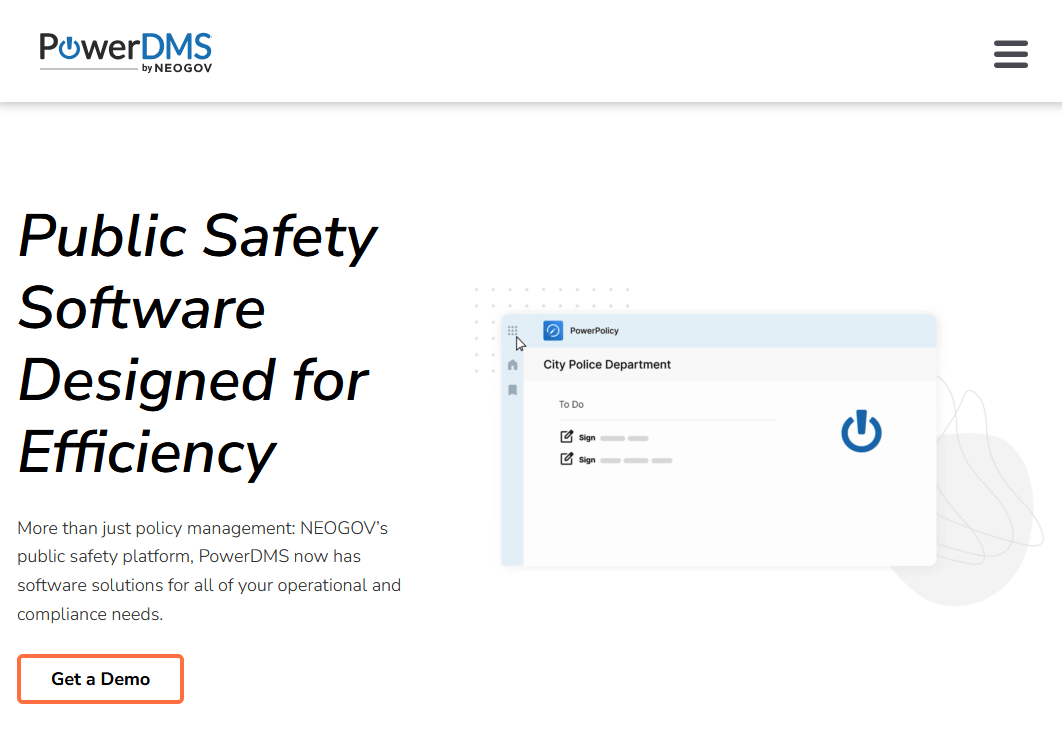
PowerDMS is a powerful policy and accreditation management platform, especially beloved in public safety, government, and healthcare sectors.
Imagine an online manual that not only houses your policies but also ensures every employee has signed off on them and helps you maintain accreditation standards, that’s PowerDMS in a nutshell.
PowerDMS is a policy and procedure manual software that replaces those gigantic 3-ring binders in police departments, fire stations, or hospitals. It’s the go-to solution for folks who need proof that policies are read and followed.
Key Features
- Central Repository: You upload your Word, PDF, or HTML policies into PowerDMS, and it becomes the central source of truth.
- Version Control and Comparison: PowerDMS saves the old version and even lets you compare differences side by side. Super useful for transparency.
- E-Signatures and Tracking: You assign policies or training documents to users and require e-signatures. The platform tracks who has signed (and who hasn’t), sending reminders to stragglers.
- Automated Workflows: PowerDMS automates the review and approval process.
- Mobile Access
- Accreditation Management: Manage accreditation standards (like CALEA for police or Joint Commission for hospitals).
Pricing
PowerDMS usually works on an annual subscription model, often based on the number of users or licenses and offers tailor packages to the sector.
My Take
PowerDMS is like a strict but fair supervisor for your policies—it makes sure everyone does their homework and that you have the receipts to prove it.
4. ComplianceBridge: Lightweight Policy Management for SMBs
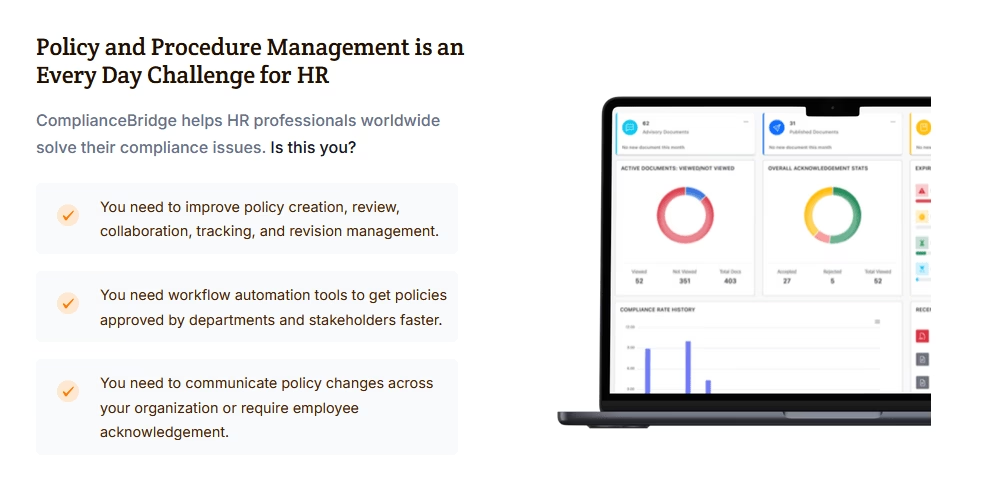
ComplianceBridge is a policy and procedure management software that targets small to mid-sized businesses and any organization needing a simpler, affordable solution.
If PolicyTech or PowerDMS sound too heavy or pricey, ComplianceBridge offers the sweet spot. It’s a cloud-based platform that helps you create, distribute, and track policies without a ton of complexity.
ComplianceBridge has been around for a while and is used in sectors like education, nonprofits, and small enterprises that want the benefits of policy management software without enterprise software hassle.
Key Features
- Policy Creation Tools: You can author policies directly in the system with a rich text editor (or import existing docs). It also supports templates for consistency.
- Automated distribution
- Read Receipts and Quiz Scores: You’ll get tracking on who has read each policy and their quiz results if you included one.
- Policy approval workflow
- Dashboard and reports
Pricing
ComplianceBridge is generally more transparent and affordable. From what I gathered, for a small organization (under 100 users), the cost is in the low thousands per year (significantly less than enterprise tools).
For me, ComplianceBridge offers good value for the price. They also offer a free trial.
My Take
If you plan on heavy customization or integration with other software, ComplianceBridge may not be the best choice. However, if you’re looking for an easy-to-use, affordable stand-alone policy portal, ComplianceBridge is an excellent choice.
5. Process Street: SOP and Workflow Tool for Procedures
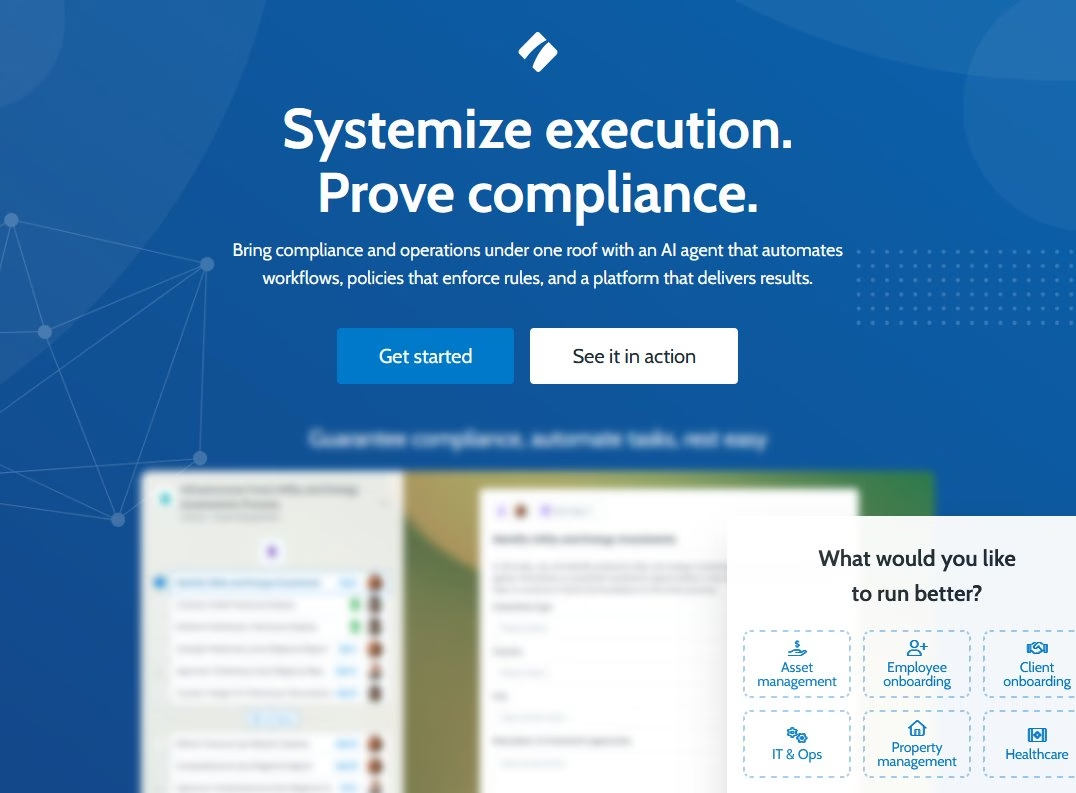
Process Street isn’t a traditional policy manual software—it’s actually a process management platform—but I’m including it because documenting procedures is its bread and butter.
If your main goal is to create step-by-step workflows or Standard Operating Procedures (SOPs) that people can actually follow (and even run as checklists), Process Street is fantastic.
It’s more like a part checklist, part documentation.
Many companies use Process Street to manage their internal knowledge and procedures, so it can certainly serve as a dynamic policy/procedure manual.
Key Features
- No-Code Workflow Builder: You can add text, images, form fields, decision points, and more.
- Process Automation: Assign tasks to specific roles/users, set due dates, or integrate with other apps.
- Templates and AI Assistance: Tons of pre-made templates for common procedures. Plus, they’ve introduced an AI-powered workflow generator that can draft a process for you from a simple description.
- Collaborative Checklists: Multiple people can be involved in a single instance of a workflow.
- SOP Documentation: Each process can be viewed in a documentation mode. Employees can reference processes when needed, or actually execute them for routine tasks.
Pricing
Process Street offers a 14-day free trial. Their paid plans you have to contact their sales team.
My Take
Process Street might not replace a policy library for things like HR policies or legal guidelines, those you might still keep in a more traditional knowledge base. But for day-to-day operational procedures, it’s a game changer.
6. Trainual: Playbook Builder for Small Businesses
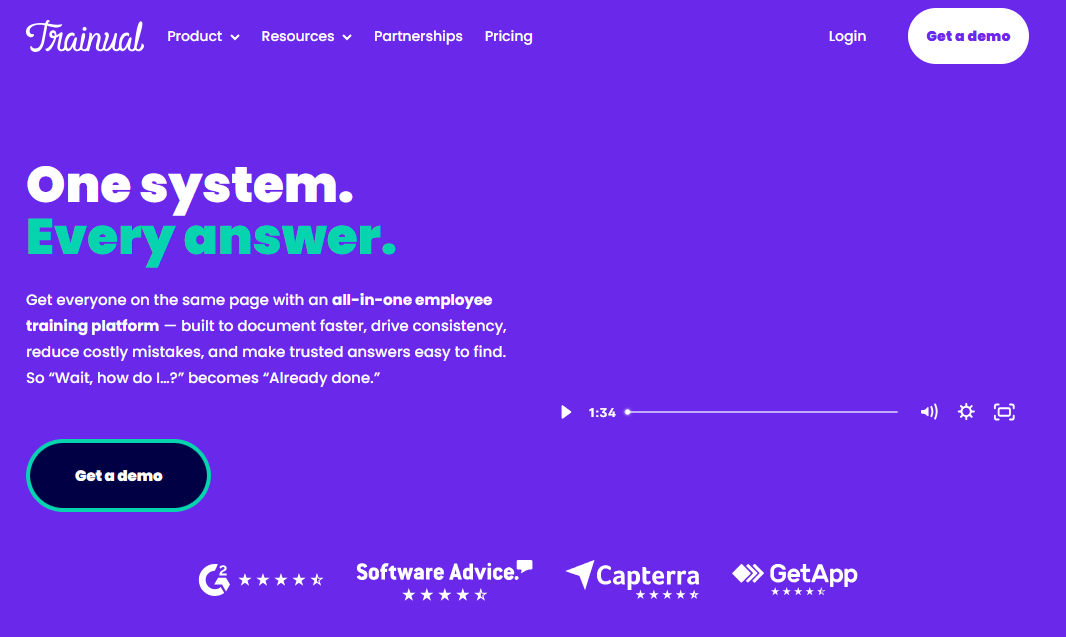
Trainual markets itself as an “online training manual” platform. Perfect for creating a company playbook or handbook that mixes policies, processes, and training content.
It’s hugely popular with small businesses and startups that need to get new employees up to speed quickly and document how things are done.
Picture a vibrant, easy-to-navigate online handbook where each department has its SOPs, each role has its how-to guides, and key policies are presented in a friendly way—that’s what I like about Trainual.
Key Features
- Subject and Topic Organization: You structure your content into subjects (like chapters) and topics (pages within those chapters).
- Multimedia content
- Quizzes and Assessments: You can add quiz questions at the end of topics to test understanding.
- Assignments and Tracking: When someone new joins, you can assign them the “Employee Handbook” and “Job Role 101” subjects.
- Templates and playbooks.
- Integrations and mobile app
Pricing
Trainual’s plans start at about $249 per month and support up to 10 users.
My Take
Trainual turns your policy manual into an interactive learning experience, which can drastically improve adoption and understanding.
7. SweetProcess: Simple Tool to Document Processes and Policies
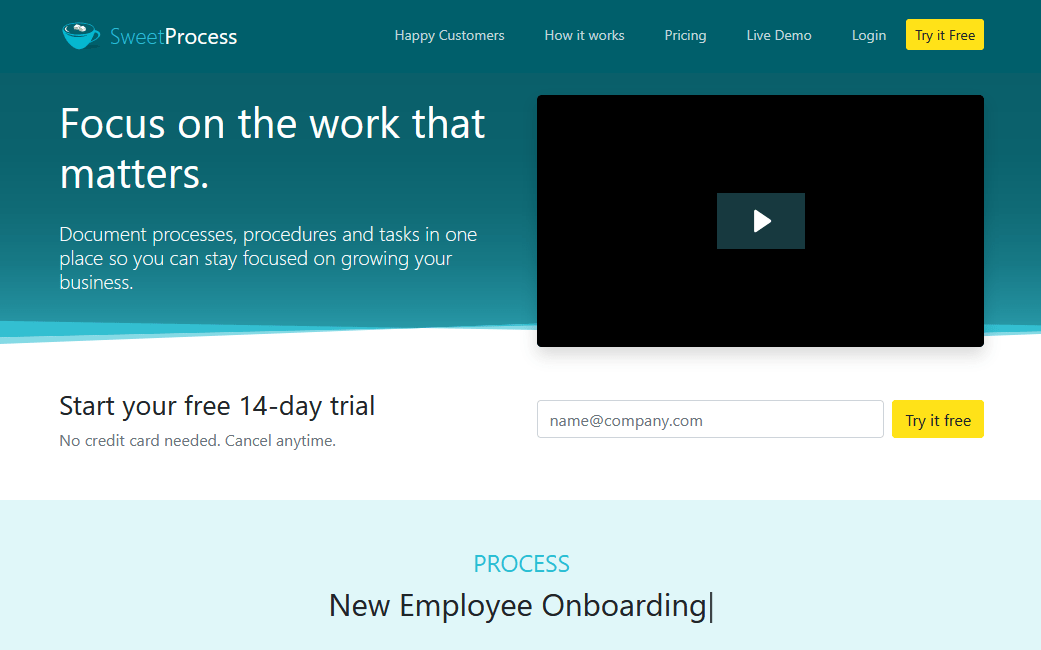
SweetProcess is a lean, user-friendly platform to document standard operating procedures (SOPs), policies, and tasks in one place.
The name says it: it makes creating processes sweet (and simple).
I recommend this tool for businesses that want to quickly get their procedures out of their heads and onto paper—or rather, onto the cloud. Without dealing with complex software.
SweetProcess can serve as both an internal knowledge base and a process management tool, complete with the ability to assign tasks and track completion.
Key Features
- Create step-by-step procedures with text and images, or draft policies with a rich text editor.
- Task Assignment and Checklists: Procedure can be turned into a checklist task and assigned to someone.
- Collaborative Editing and Approval: Team members can suggest edits to processes, which managers can approve.
- Create public and private knowledge base
- Quizzes: With quizzes, you can test employees on the content of a procedure or policy.
Pricing
SweetProcess can cost you $99 per month, this supports up to 20 team members.
They also offer a free trial and exclusive pricing for smaller teams with fewer than 20 members.
My Take
SweetProcess is powerful enough to cover all the necessary features for managing policies and procedures, yet simple enough that everyone actually uses it.
8. ConvergePoint: Policy Management on SharePoint
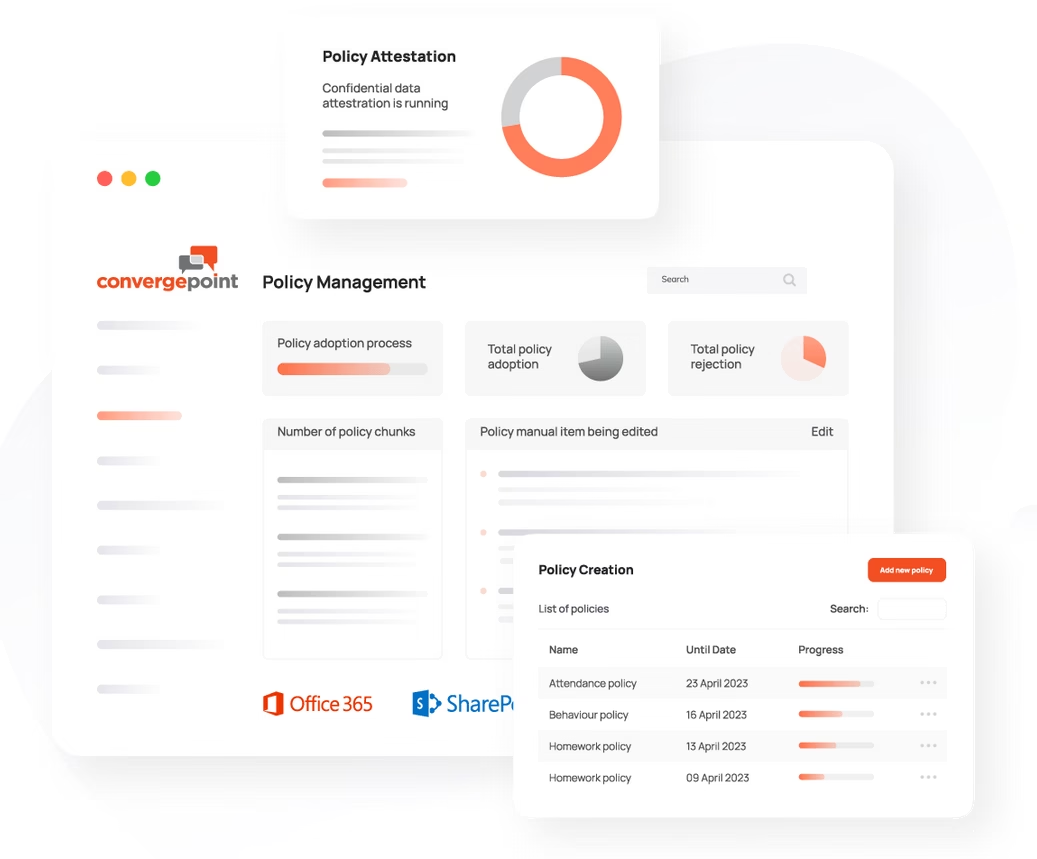
ConvergePoint is a robust policy and procedure management system for Microsoft SharePoint.
If your organization lives and breathes Microsoft (SharePoint, Office 365, Teams, etc.), ConvergePoint lets you leverage that ecosystem to manage policies seamlessly.
It’s an add-on that transforms SharePoint into a full-fledged policy management platform with workflows, approvals, and compliance tracking.
Key Features
- Lifecycle Workflow: It covers the entire policy lifecycle – Draft -> Review -> Approve -> Distribute -> Audit -> Renew.
- SharePoint Integration: It uses native Microsoft tools like Word for editing (with track changes), Outlook and Teams for sending notifications, and Active Directory for user permissions.
- Metadata and search
- Automated alerts and tasks
- Audit Trails and Reporting: Every action like draft edits, approvals, who viewed or signed off is logged.
- Additional Modules: ConvergePoint also offers related modules (conflict of interest disclosures, contract management, etc.)
Pricing
Being an enterprise solution, ConvergePoint pricing will depend on your SharePoint environment and number of users. For which you have to reach their team.
My Take
ConvergePoint is a perfect fit for organizations deeply embedded in the Microsoft ecosystem. Its SharePoint integration keeps policy management in one place, live editing saves time, and the initial setup is smooth once IT handles it.
9. RLDatix: Healthcare-Focused Policy Management
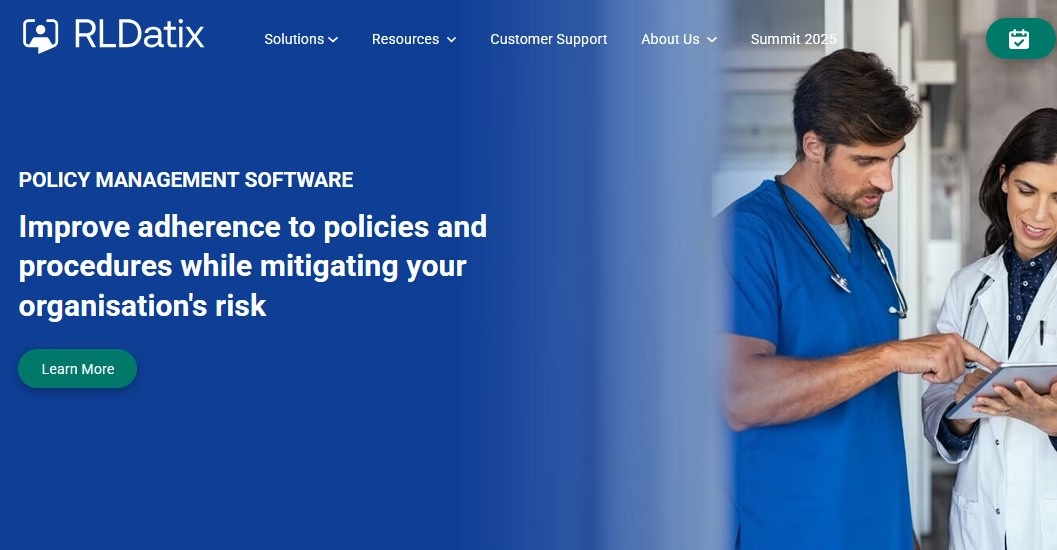
RLDatix (previously PolicyStat) is a well-known policy management software in the healthcare space.
I recommend RLDatix for hospitals, clinics, and life science companies because they have unique policy and procedure management needs. Think of strict regulatory standards, frequent audits, and staff who are often more focused on care than navigating software.
It is designed to make policy management easier in such environments.
Key Features
- All policies and procedures are stored in a web-based repository that staff can search with ease.
- Smart editor and templates to maintain consistent formatting across policies.
- Automated approval workflows
- Staff Acknowledgment: For critical updates (say a new infection control protocol), you can require staff to acknowledge they’ve read it.
- Audit trails (version history) and reporting
- Integration and Single Sign-On: It often integrates with hospital intranets or SharePoint, and supports single sign-on so staff don’t need a separate login.
- Compliance and Search Analytics: PolicyStat can analyze which policies are being accessed frequently, which might indicate training opportunities or highlight critical content.
Pricing
Quote based. RLDatix is generally offered via annual subscription. It’s usually scaled by organization size or number of facilities.
My Take
If you’re in healthcare, RLDatix is almost a de facto standard for policy management, and there’s a reason: it understands the environment and demands of that field like no generic tool could.
10. Atlassian Confluence: Team Wiki for Policies and Procedures
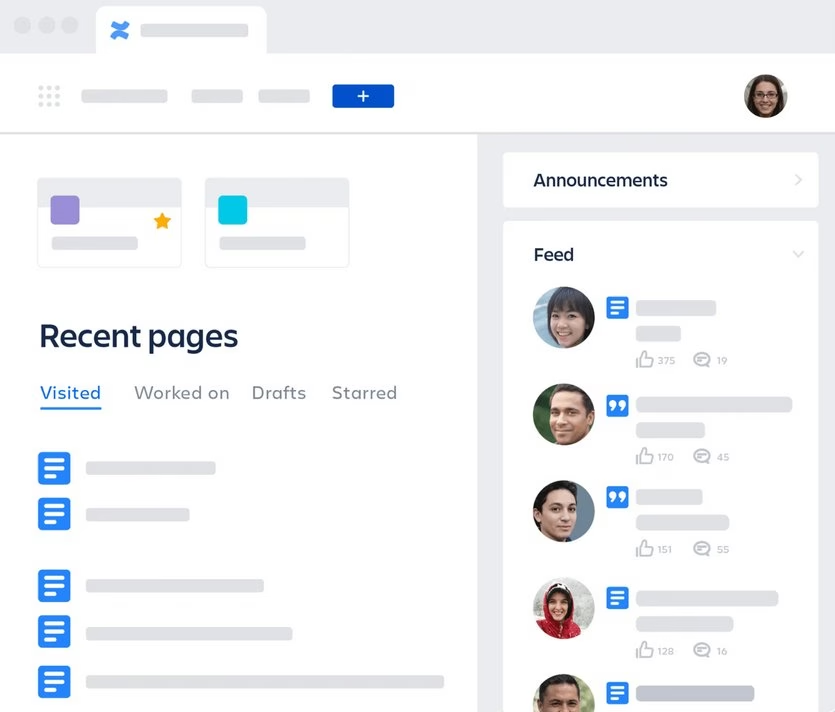
Confluence by Atlassian is a corporate wiki software. Think of Confluence as a digital hub where all your company’s knowledge, including policies and SOPs, can live and evolve collaboratively.
It’s battle-tested for teams of all sizes. If you have a technical or globally distributed team, chances are someone’s already suggested Confluence for documentation.
Key Features
- Spaces and Pages: You can set up dedicated spaces for different departments or projects (e.g., an “HR Policies” space, an “Operations Manual” space). Within spaces, create pages and nested sub-pages for each policy or procedure.
- Real-Time Collaboration: Multiple team members can edit a Confluence page together, Google Docs style.
- Templates and Macros: Comes with handy templates for policies, meeting notes, etc.
- Permissions and Audit Trails: Confluence has granular permission settings at the space or page level. You can restrict viewing or editing rights easily.
- Integrations: Being part of the Atlassian family means Confluence plays nice with tools like Jira and Trello, and it has plugins for almost anything (from diagram tools to workflows).
Pricing
Confluence has a free plan for up to 10 users—awesome for small teams.
The Standard cloud plan runs at about $5/user per month, and Premium around $10/user with advanced admin controls and analytics.
For large enterprises, there’s an Enterprise tier with custom pricing.
My Take
Confluence is a reliable software for many. If you want a collaborative, wiki-style solution for policies and procedures, Confluence is a top choice with a generous free tier.
11. Notion: All-in-One Workspace for Manuals and More
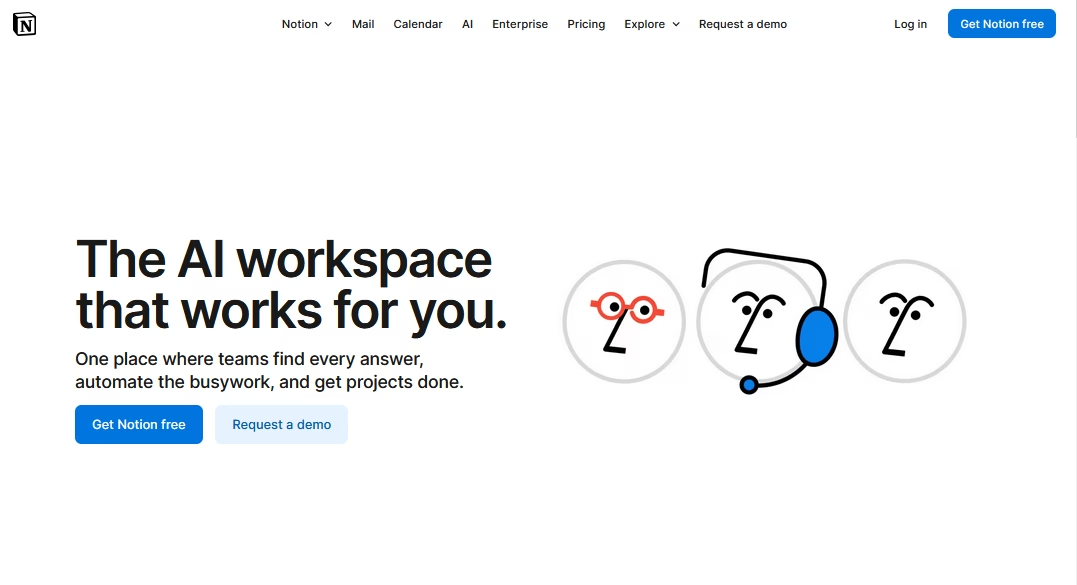
Notion is a wildly popular all-in-one workspace tool that many teams use as an internal wiki or handbook.
It’s incredibly flexible, essentially a blank canvas where you can create pages, databases, to-do lists, you name it.
For policy and procedure manuals, Notion can be a breath of fresh air because of its modern interface and ease of editing.
You can build a company wiki with beautiful pages for each policy, interlinked and multimedia-rich. It’s like building your own internal website, without needing web design skills.
And given that Notion offers a free plan for personal use and inexpensive team plans, it’s an attractive option for small organizations on a budget.
Key Features
- Flexible Page Structure: In Notion, everything is a block that you can drag and drop. You can create hierarchical page structures with infinite nesting.
- Rich Content and Media: Embed images, videos, PDFs, and even integrations like Google Maps or Figma designs into a Notion page.
- Databases and templates
- Real-time collaboration like Google Docs
- Permissions and sharing to control access by page or section, invite specific people or make pages available to the whole team.
- Search and tags to find information faster
- Aesthetic and Customization: Notion pages just look nice by default, and are very customizable.
Pricing
Notion’s is free to start. For teams, the Team plan is about $10 per user per month (with unlimited pages and blocks), and that drops with annual billing.
My Take
Notion is like the cool, modern notebook for your company’s knowledge. It makes writing and reading policies more approachable, which means people are more likely to actually read them. And an easy-to-read, frequently-referenced policy is exactly what you want in a manual, right?
Final Thoughts
Choosing the best policy and procedure manual software depends on your organization’s size, industry, and specific needs.
For some, a simple knowledge base software like Heroic Knowledge Base or SharePoint add-on will do.
For others, especially those in heavily regulated sectors, a full-fledged policy management and compliance platform is essential.
No matter which tool you go with, a few final tips from my experience:
- Involve your team in the process
- Keep your manuals concise and accessible
- Use the software’s features (search, analytics, quizzes) to continuously improve how policies are communicated.
Happy documenting, and good luck finding the perfect tool that makes your policy manual heroic in its own right!
Further Reading
How To Create Policies & Procedures Manual Step-By-Step Guide
10 Best Free Software Documentation Tools for Developers
How To Write an Instruction Manual: Beginner’s Guide With Example
Software User Manual: The Ultimate Guide With a Template
5 Powerful Lessons From Amazon’s Returns Policy
9 Best User Manual Examples to Learn From (2025 Guide)



